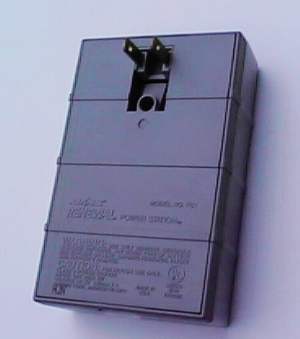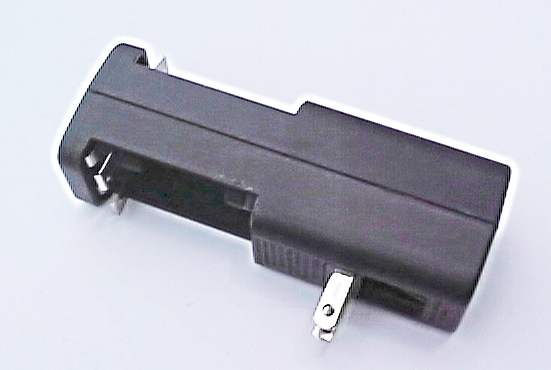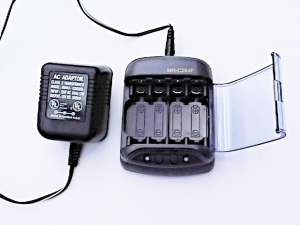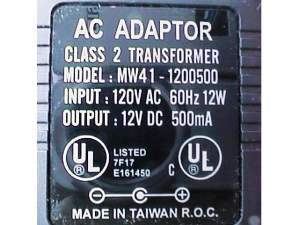

Chargers
June 25 '99
If you don't know much about the rechargeable concept and theory,
look here first.
Chargers come in all types to charge cells such as AAA, AA, C, D, 9volt square, and specialty types for battery packs used in radios, cell phones, flashlights, GPS units, FRS and CB walkie-talkies, FM two-way radios, computer laptops, etc.
Wal-Mart and Radio Shack sell most of the popular types. Others usually come with the radios or cell phones when purchased. Batteries that can be charged are NiCad, NiMH, Li-ON, and lead acid. NEVER try to recharge an alkaline battery no matter what the claims are. They will leak and damage your equipment beyond repair. Never store alkaline batteries in your equipment for long periods of time. They will leak!
There is a new generation of chargers now called "smart chargers". They have a processor in them and send pulses of power to the cells and monitor their charge capacity and shut themselves down when the battery is fully charged. Some even have a "conditioner" in them to deep cycle the cells and bring them up to full capacity. One company in particular is MAHA. They can be purchased on the web from: Thomas Distributing. My favorite unit is the C204F-Kit. I use it all the time with my fold-up solar panel that I can slip into my back pocket. Details will soon follow on building a good "smart" solar rapid charger using this device.
Chargers come in many different configurations depending on the user's needs. There is no standard type of charger or no standards when it comes to charging circuits. With some chargers, if you accidentally leave them charging for a few days, they will overheat and "cook out". This means the electrolyte (the wet chemicals) inside the cells dry out and render the battery pack useless. Lead-acid batteries, usually found in older camcorders will go bad quickly if stored discharged for a long period of time. They will also "self discharge" if left unused after a month or so. All rechargeable batteries will self discharge in a few months depending upon the type (Lead-acid gelled, NiCad, NiMH, LiON). Non-rechargeable cells (alkaline, mercury, lithium, carbon-zinc) can last for years if kept stored properly. The term of duration of storage life is called "shelf life".
Alkaline cells will loose their capacity when exposed to cold or cool temperatures. In the "old days" people used to store their batteries in the refrigerator to prolong their life. This was true for carbon-zinc batteries stored in a non-frost free refrigerators used in the 40's through 60's. The moisture caused the cells to "bounce back" to life. I knew someone who kept a few cartons of alkalines in a frost free refrigerator hoping to extend their lives. He couldn't understand why they wouldn't work in his equipment fresh from the refrigerator and threw them all away. The cool temperatures and the absence of moisture dried out the cells. Usually the alkalines will gain their capacity back to some extent if allowed to return to room temperature.
Chargers with built in AC prongs are not desirable for modification without going inside and bypassing the AC portion and I don't recommend that to the inexperienced. Two units below I would steer away from for solar projects although they are fine for normal AC usage.


My personal favorite the the MAHA C204F. It charges and conditions AA and AAA NiCad's or NiMH cells, two at a time with a total of four. The power requirement is 12 volts and 1/2 amp. Something easily obtained from a solar panel that I will show how to build soon. My fold up panel array, and this unit is all I need to recharge AA cells for my FM two-way radios, Garmin GPSIII, penlight flashlights, Portable CD player, AM/FM radio and FRS walkie-talkies. It takes just under 1 hour to bring four AA penlight cells to full charge. You can push a button at the bottom of each pair of cells and "cycle" the cells. This discharges them and brings them back up to full. This is called "conditioning" of the cells and is required to be cycled at least 6 times for all new rechargeable cells when first purchased.

You can see a close up of the tag on the transformer showing its output capabilities.

Note the small drawing at the bottom showing the polarity of the plug. Center is the positive and the shell is the negative.
Okay. So some of you have given up already and the discussion is too technical, and you don't have time or the patience to build a solar charger. Looky here!